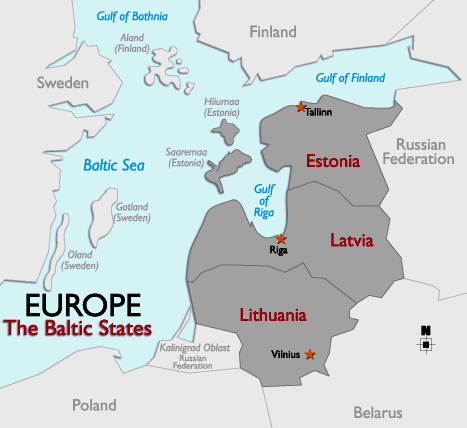
The Baltic states Estonia, Latvia, and Lithuania are three northern European countries east of the Baltic Sea. The States co-operate on regional level in several intergovernmental organizations. While the indigenous populations of Latvia and Lithuania are known as Baltic peoples, those of Estonia are Finnic peoples. Another Baltic identity, Baltic German, began to develop during the Middle Ages after the Livonian Crusade.
Linguistic and historical considerations intersect in defining the concept of "Baltic states": for example, while Latvian is phylogenetically related to Lithuanian (both belonging to the Baltic group of the Indo-European language family) Estonian belongs to a completely different family – the Uralic languages. At the same time, despite considerable linguistic proximity, politically Latvia and Lithuania have gone different ways for most of their history, Lithuania at one point forming a commonwealth with Poland, giving rise to one of the largest countries in Europe at the time; while Latvia has shared most of its history with Estonia, both being governed by a Baltic German élite for more than 700 years. The Livonians (a nearly extinct ethnic group closely related to Estonians) have also participated in the ethnogenesis of Latvians: according to most accounts, the assimilation of (Uralic) Livonians by ancient (Indo-European) Baltic tribes formed the basis of what are today known as the Latvian language and Latvians. |
Baltic countries are located in Northern Europe and have a seaside; thanks to that they are able to interact with many European countries. All three countries are parliamentary democracies, which have unicameral parliaments that are elected by popular vote to serve four-year terms. In Latvia and Estonia, the president is elected by parliament while Lithuania has a semi-presidential system and the president is elected by popular vote. All are parts of the EU and the NATO.
Each of the three countries has declared itself to be the restoration of the sovereign nations that had existed from 1918 to 1940, emphasizing their contention that Soviet domination over the Baltic nations during the Cold War period had been an illegal occupation and annexation. The same legal interpretation is shared by the United States, the United Kingdom, and all other Western democracies, who always considered the forcible incorporation of Estonia, Latvia, and Lithuania into the Soviet Union to be illegal. At least formally, the Western democracies never considered the three Baltic states to be constituent parts of the Soviet Union. After the Baltic states had restored independence, integration with Western Europe was chosen as the main strategic goal. |
In 2002 the Baltic nations applied to become members of the North Atlantic Treaty Organization (NATO) and the European Union (EU). Membership of NATO was duly achieved on 29 March 2004, and accession to the EU took place on 1 May 2004. The Baltic States have been the only former-Soviet states to join either NATO or the EU at that time.
The peoples comprising the Baltic states have together inhabited the eastern coast of the Baltic Sea for millennia, although not always peacefully in ancient times, over which period their populations, Estonian, Latvian, and Lithuanian have remained remarkably stable within the approximate territorial boundaries of the current Baltic states. While separate peoples with their own customs and traditions, historical factors have introduced cultural commonalities across and differences within them. The population of the Baltic countries belong to different Christian denominations, a reflection of historical circumstances. Both Western and Eastern Christianity had been introduced by the end of the first millennium. The current divide between Lutheranism to the north and Catholicism to the south is the remnant of Swedish and Polish hegemony, respectively, with Orthodox Christianity remaining the dominant faith among Russian and other Slavic minorities. |
